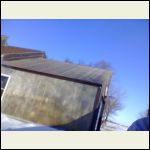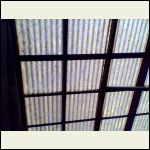|
| Author |
Message |
creeky
Member
|
# Posted: 20 Jan 2015 10:55am
Reply
I'm interested in how people are using passive solar to heat their buildings.
I've been experimenting with passive solar as a means of heating my small buildings for three years.
Two falls ago I installed six small windows on the south side of my wash house (20 sq ft, argon filled/e-coated, double pane). The wash house, if you've followed my build, is sheathed in 3.5" of polyiso panels fitted onto a miniature pole barn (8x16, 10' ceiling).
The result is notable. This morning the temperature (kept at 54F (12C) was already 61 (16) at 9:30; and by 10:30 is 70 (21). Given that it is -4F (-20C) outside I consider this a good result. I am spending no money, burning no fossil fuels.
This year I also added a large water barrel (so my shower water doesn't freeze, but it also adds thermal mass and is exposed to the sun coming through the windows). I can't quantify the result, but when the propane tank went empty the bath house went overnight (12-14 hrs) with no heat. The temperature in the house only dropped to 36F while the outdoor temp dropped to -10F). The additional thermal mass must have played a role. The water should have radiated around 750 btus.
I had last years results on the washroom when I built my winter bedroom (the chalet). I have used a similar solar gain strategy. A little bit more insulation, a fair bit less window (8 sqft/argon/e-coated). The result is not as dramatic. But the room, which I keep between 16-18C (60-65F) is, as of 10:30, 19C. So again, I am using no propane to heat.
Heating small buildings in days of extreme cold for free is, of course, a great joy.
Anybody else have a good solar strategy to share?
|
|
MtnDon
Member
|
# Posted: 20 Jan 2015 11:08pm - Edited by: MtnDon
Reply
Be aware of your climate zone and how windows are designed for specific climates. The northern areas of the US and all of Canada have very different rules or design criteria for windows when compared to a large amount of the US. Low-e windows can be designed to permit less than 25% solar heat gain or to permit virtually all the solar heat to pass througkh the window. The factor is known as SHGC, solar heat gain coefficient. In the north windows are usually made with no SHGC rules, or the SHGC allows most of the suns radiant energy to pass through to the interior. Not so further south.
See map and other info here
And another site I find informative
We spend more dollars to cool in summer than to heat in winter. When we replaced the 1985 windows in our home I had the windows spec'd out for lower heat gain than the ones that were usually sold. They allow very little heat gain. Maybe we lose out a little in winter, but as I stated, the costs to run electric A/C are higher than the costs to heat with low cost natural gas or wood.
Just something to think about. By US law windows have to have a SHGC matched to the energy code guidelines for the geographic area. So if heat gain is desired the standard offerings may not be the best. It is possible to buy "northern" windows in the south, but it can be difficult as there are energy code rules that are in place.
FWIW, the SHGC can be modified in the south by designing eve overhangs that provide summer shade but permit winter sunshine to strike window glass. We did that on our cabin so there we have the benefit of winter heat gain but have full glass shading in the summer. Same thing can be effective in the north.
|
|
creeky
Member
|
# Posted: 21 Jan 2015 08:59am
Reply
Windows specifically designed for your climate attributes are an excellent point. My windows have both the argon gas for heat retention and the SHGC (modified by the "energy" coating on the windows) necessary for this area.
That was the big surprise for me. I bought these windows out of a garage where'd they'd been sitting for a few years. $6/ea. Imagine my surprise when I found out they were e-coat/argon! And the SHGC modeled perfectly for my climate. The guy who bought them in the first place knew what he was doing.
Also: excellent point on the use of eves. This regions summer sun angle is very high, so I use 1 foot overhangs to reduce solar gain.
Also, one of the blessings of my property is the heavy tree cover. In the summer I get a lot of shade (and the trees are one reason my solar shed is 200 feet from my "great room").
It's also one reason I carefully left the wild grape vines in place when I built the chalet. In the summer they will completely cover the windows. And imagine how "cool" that will be, to lie in bed looking out through a screen of green.
So think about planting shrubs, vines and trees to modify solar gain.
Great add MtnDon.
|
|
Pookie129
Member
|
# Posted: 23 Jan 2015 05:27pm - Edited by: Pookie129
Reply
URL
Interesting - Roof pond systems (southern hemi for heating)
Six to twelve inches of water are contained on a flat roof.
This system is best for cooling in low humidity climates but can be modified to work in high humidity climates. (Effectively provides heat in southern U.S. latitudes during the heating season for one story or upper stories of buildings.)
Water is usually stored in large plastic or fiberglass containers covered by glazing and the space below is warmed by radiant heat from the warm water above.
These require somewhat elaborate drainage systems, movable insulation to cover and uncover the water at appropriate times, and a structural system to support up to 65 lbs/sq ft dead load.
|
|
creeky
Member
|
# Posted: 24 Jan 2015 11:20am
Reply
that URL is quite interesting.
some of the information in the passive solar area is dated, in particular the thermal chimney. I designed a "thermal chimney" roof to remove the excess heat generated by a tin roof in the summer that works really well.
It would appear that early solar chimneys were hugely oversized. A thinner chimney means more energy in the air (hotter air); which moves faster; and with speed comes the cooling efficiency. A greater volume of air is moved taking with it more btus.
you can see my design (it's passive solar cooling) about 2/3s of the way down my "creeky's camp build" URL
It's been in place for two full years now and I continue to enjoy the efficiency.
If we look at Figure 6 in the passive solar section of the URL pookie provided you see something similar to my design. Build it solar also has a similar design for solar heating where you draw cool room air in at the bottom and run the heated air back into the room at the top. I've been meaning to build one. This summer. Lol. (been saying that for two years now. well. that's the lesson. it's quicker to come up with ideas than build them, but eventually it all gets done).
Again, the builditsolar design uses a narrower or thinner heating channel than the older solar chimney designs. Interesting how easy it would be to combine the two designs for use as both a heating and cooling device.
Gee. I might modify my design now.
The standing water roof is an interesting idea for sure.
|
|
Pookie129
Member
|
# Posted: 24 Jan 2015 11:31am
Reply
I am just learning about passive solar benefits and this thread is very helpful and interesting. and with some experienced individuals here already using this and providing more information, I am definitely going to experiment once the weather gets warmer with some passive solar ideas around camp.
Thanks for posting this up - absolutely has peak my interest.
|
|
Just
Member
|
# Posted: 26 Jan 2015 10:19am
Reply
The garage on my home in Ontario has passive solar . built in 1978 it has served us well .
this morning at 9.45 am it is -14 c outside and + 9 in my shop __ garage ' no other heat source except a common wall with our home .
It is covered with a product called Excolite , been very durable .
Originally I had hoped to harvest some of the heat from it to supplement the homes heat , but that is only possible a few days a year and on toughs days the homes windows produce enough heat by themselves.
Good luck with your project .
Snapshot_20150126_3..jpg
| 
Snapshot_20150126.JP.jpg
|  |  |
|
|
Pookie129
Member
|
# Posted: 27 Jan 2015 08:28pm
Reply
URL
Interesting challenge and idea.
NET ZERO HEAT Challenge
Net Zero Heat, Net Zero Energy
Net Zero Heat is
A building envelope designed for its specific climate so that no heat source beyond the sun is required to maintain a comfortable room temperature.
|
|
|
|

